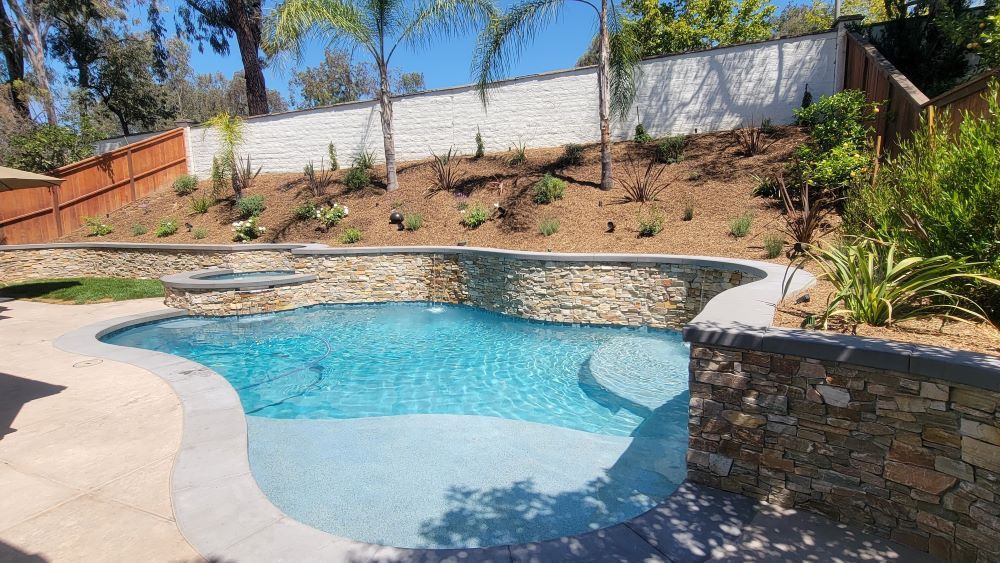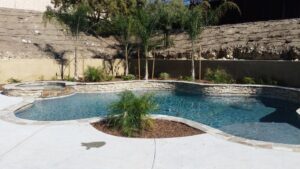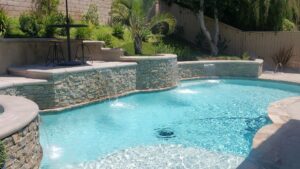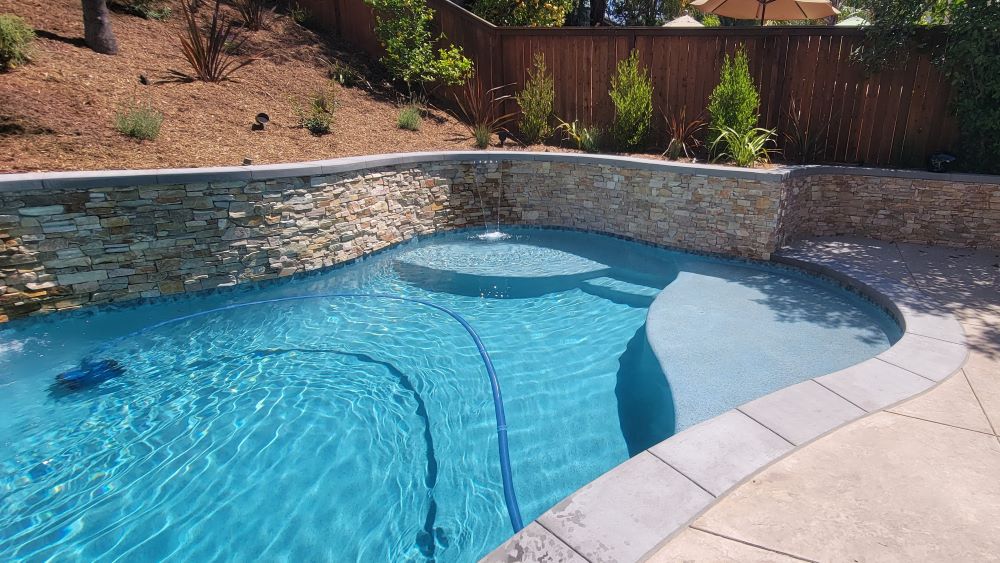Building a swimming pool on a slope can present unique challenges that require careful planning and execution. Unlike constructing a pool on a flat surface, building on a slope introduces additional factors to consider, such as structural integrity, drainage, and overall aesthetics. As you embark on this project, it’s essential to understand the complexities involved to ensure a successful and visually stunning outcome.
One of the primary challenges of building a pool on a slope is maintaining the structural stability of the pool itself. The uneven terrain can put significant stress on the pool’s structure, potentially leading to cracks, leaks, or even complete failure if not addressed properly. Additionally, the slope can impact the pool’s depth, making it more challenging to achieve a uniform water level throughout the entire pool if that design is desired.

Evaluating the Site and Soil Conditions
Before you begin the design and construction process, it’s crucial to conduct a thorough evaluation of the site and soil conditions. This assessment will help identify any potential issues or limitations that may impact the pool’s construction and long-term performance.
A primary consideration is examining the slope’s gradient and direction. Steeper slopes will require more extensive engineering and construction techniques to ensure the pool’s stability. Additionally, consider the soil composition, as certain soil types, such as clay or expansive soils, may require specific measures to prevent foundation issues.
It’s also important to assess the site’s drainage patterns and any existing water sources or underground utilities that may need to be addressed during the construction process. This information will be crucial in determining the most appropriate construction methods and drainage solutions for your sloped pool project.
Planning and Design Considerations for a building a Swimming pool on or within a slope
 When designing a swimming pool to be built on a slope, you’ll need to carefully consider a range of factors to ensure the pool’s functionality, safety, and visual appeal. An experienced pool designer or landscape architect is critical to ensure all factors are being considered. That experience is vital in developing a comprehensive plan that addresses the unique challenges of your site.
When designing a swimming pool to be built on a slope, you’ll need to carefully consider a range of factors to ensure the pool’s functionality, safety, and visual appeal. An experienced pool designer or landscape architect is critical to ensure all factors are being considered. That experience is vital in developing a comprehensive plan that addresses the unique challenges of your site.
One key consideration is the pool’s shape and orientation. Rectangular or geometric pool designs may be more challenging to integrate into a sloped landscape, while freeform or organic shapes can often better complement the natural contours of the site. Additionally, positioning the pool in a way that maximizes the available flat space and minimizes the need for extensive excavation or retaining walls can be advantageous.
Choosing the Right Construction Method for a Pool Being Built on a Slope
The construction method you select for your pool being built on a slope will have a significant impact on the overall success and durability of the final result. Traditional in-ground pool construction techniques, such as gunite (shotcrete) will need to be modified to address the unique challenges of a sloped site.
A gunited pool will require more steel and possibly thicker walls and floors to account for the pressures of the slope on the structure of the pool. The information of the site that is given to the engineering company is critical. This means the pool engineering is only as good as the information they receive from the designer or architect.
Dealing with Drainage and Water Management
Effective drainage and water management are critical considerations when building a swimming pool within a slope. The pool’s location and the surrounding landscape can significantly impact the flow of water, potentially leading to erosion, flooding, or other issues if not properly addressed.
Construction considerations such as incorporating a comprehensive drainage system into your pool design, including strategically placed drains, French drains, or other water management solutions is paramount. This will help ensure that excess water is efficiently directed away from the pool area and any adjacent structures or landscaping. Additionally, consider the use of retaining walls or terracing to help control water flow and prevent erosion on the sloped site.
Retaining Walls and Structural Support for a Sloped Pool
 To maintain the structural integrity of a swimming pool on a slope, you may need to incorporate retaining walls or other forms of structural support. Retaining walls can help stabilize the pool’s foundation, prevent soil erosion, and create level surfaces for the pool and surrounding areas. These retaining walls can be built to reduce the pressure of the slope on the swimming pool or to create space in between the pool and the slope. Keep in mind, a swimming pool will still require special engineering if it is near a retaining wall because the retaining wall still creates different pressure on the pool than just flat earth around the pool.
To maintain the structural integrity of a swimming pool on a slope, you may need to incorporate retaining walls or other forms of structural support. Retaining walls can help stabilize the pool’s foundation, prevent soil erosion, and create level surfaces for the pool and surrounding areas. These retaining walls can be built to reduce the pressure of the slope on the swimming pool or to create space in between the pool and the slope. Keep in mind, a swimming pool will still require special engineering if it is near a retaining wall because the retaining wall still creates different pressure on the pool than just flat earth around the pool.
When designing the retaining walls, it’s essential to work with a structural engineer who can determine the appropriate materials, size, and reinforcement required to withstand the specific soil conditions and slope of your site. Additionally, consider the aesthetic impact of the retaining walls and how they can be integrated into the overall landscape design.
Incorporating Safety Features into a pool Built on a Slope
Building a swimming pool on a slope introduces unique safety considerations that must be addressed in the design process. Factors such as changes in pool depth, potential slippery surfaces, and the risk of falls or accidents due to the uneven terrain require special attention.
Incorporating safety features such as non-slip surfaces, strategically placed handrails, and clear visual cues to indicate changes in depth or elevation are just some of the safety approaches to be considered. Additionally, bear in mind the installation of safety barriers or fencing around the pool’s perimeter to prevent accidental falls or unsupervised access, especially if the pool is situated on a steep slope.
Landscaping and Aesthetics for a Stunning Pool Built on a Slope
 One of the key advantages of building a swimming pool on a slope is the opportunity to create a visually stunning and integrated landscape design. The natural contours of the site can be leveraged to enhance the overall aesthetic appeal of the pool and its surrounding areas.
One of the key advantages of building a swimming pool on a slope is the opportunity to create a visually stunning and integrated landscape design. The natural contours of the site can be leveraged to enhance the overall aesthetic appeal of the pool and its surrounding areas.
Collaborating with a landscape designer or architect to develop a cohesive plan that seamlessly blends the pool, any necessary retaining walls or structures, and the surrounding landscape is a key to success. Consider the use of terraced gardens, strategically placed plantings, and hardscaping elements to create a harmonious and visually appealing outdoor living space. Again, our design team is well versed (and licensed) to incorporate a seamless landscaping plan for your sloped swimming pool project.
Maintenance and Upkeep of a Swimming Pool Built on a Slope
Maintaining a swimming pool on a slope requires special attention and considerations to ensure its long-term functionality and appearance. Regular inspections and proactive maintenance are essential to address any potential issues, such as cracks, erosion, or water management problems.
Establish a comprehensive maintenance plan that includes regular pool cleaning, water testing and treatment, and the inspection of the pool’s structural components and drainage systems. Additionally, be prepared to address any landscaping or erosion-related concerns that may arise over time, as the slope can introduce additional challenges compared to a flat pool installation.
Conclusion
Building a swimming pool on a slope can be a complex and challenging undertaking, but with the right planning, design, and construction methods, it can also be a highly rewarding and visually stunning project. By carefully evaluating the site conditions, choosing the appropriate construction techniques, and integrating thoughtful safety and landscaping elements, you can create a one-of-a-kind pool that seamlessly blends with the natural contours of your property.

We would be honored to be a part of your custom pool landscape design project. Infinite Pools is C-27 certified and fully licensed to support your efforts. We celebrate 20 years this year of designing and constructing over 1,500 custom pools for our clients. Please contact us today so together we can take the next step toward your dream pool.





